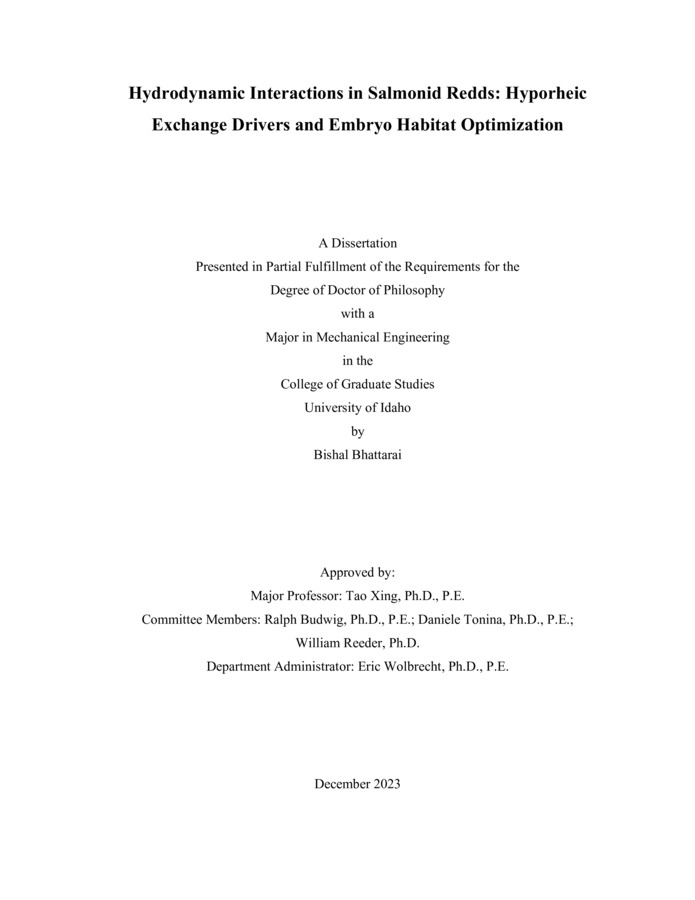Hydrodynamic interactions in salmon redds: Hyporheic exchange drivers and embryos habitat optimization
Bhattarai, Bishal. (2023-12). Hydrodynamic interactions in salmon redds: Hyporheic exchange drivers and embryos habitat optimization. Theses and Dissertations Collection, University of Idaho Library Digital Collections. https://www.lib.uidaho.edu/digital/etd/items/bhattarai_idaho_0089e_12631.html
- Title:
- Hydrodynamic interactions in salmon redds: Hyporheic exchange drivers and embryos habitat optimization
- Author:
- Bhattarai, Bishal
- ORCID:
- 0009-0005-9608-285X
- Date:
- 2023-12
- Keywords:
- bed permeability egg pockets Hyporheic flows Salmon redd turbulence modeling waterbed roughness
- Program:
- Mechanical Engineering
- Subject Category:
- Mechanical engineering; Hydraulic engineering; Hydrologic sciences
- Abstract:
-
Salmonids are known for their spawning behaviors, which involve creating dune-shaped egg nests called redds in streambed gravel. The survival of salmon embryos critically dependents on downwelling oxygen-rich stream water fluxes, which are influenced by a confluence of factors, including the redd’s morphology, stream hydraulics, and hydraulic conductivity of the redd sediment (K). Our investigation encompasses three major aspects: (1) the impact of stream discharge and redd geometry on downwelling fluxes, (2) the influence of bed roughness, egg pocket location, and egg pocket permeability on the hyporheic flows, and (3) the evaluation of various Reynolds-Averaged Navier-Stokes (RANS) turbulence closures for accurately simulating the complex open channel flows over redds. To achieve this, we simulated the surface and subsurface flows with numerical hydraulic models linked through the near-bed pressure distribution quantified using a two-phase (air-water) two-dimensional surface water computational fluid dynamics (CFD) model, validated with experiments.In the first part, we hypothesized that downwelling fluxes in the redds are influenced by stream discharge and the redd aspect ratio (AR =A/L, with A, the redd amplitude and L, its length). We examined five different redd sizes ranging from ~1 to ~4 m long under varying discharge conditions, from shallow (0.1 m) and slow (0.15 m/s) to deep (8m) and fast (3.3 m/s). Our results confirmed that downwelling fluxes increase with discharge and AR, due to the increased near-bed head gradient over the redd. Additionally, we proposed a regression equation involving stream flow Reynolds (Re) and Froude (Fr) numbers and AR to predict these downwelling fluxes, which may help evaluate the impact of regulated and unregulated flows on hyporheic flows during embryo incubation. In the second part, we addressed how salmon spawning activities, which alter streambed morphology to form redds, impact hyporheic fluxes. We examined the effects of streambed roughness, egg pocket permeability, and their location within the redd on the downwelling flows in egg pockets (qep). Our results indicated that the dimensionless flux into the egg pocket, q ̅_ep^*=q ̅_ep/K_D increases noticeably with the downstream distance of egg pockets from the redd pit, and less strongly with 〖K_EP〗^*=K_EP/K_D . The near-surface downwelling fluxes significantly increase with vertical roughness scaling (R1), but minimally when the roughness is scaled both vertically and horizontally (R2). This study suggests that the typical simplification of a smooth redd surface with uniform hydraulic conductivity is a valid approximation for predicting interstitial flows within redds. The third part of our study evaluates the performance of various RANS turbulence models in simulating complex open channel flows over the redds. The models tested include the standard k–ω, SST k–ω, and realizable k–ε, as well as different wall treatments for the realizable k–ε model. Our analysis reveals that while all models capture the bulk flow characteristics, there are substantial differences in their precision for specific flow features. The realizable k-ε model, particularly with standard wall function and mesh resolving the viscous sublayer, excels in predicting near-wall flow separations and velocity fields, and the SST k–ω model provides best predictions of turbulent kinetic energy but tends to overestimate separation vortex magnitudes. This study highlights the variability in accuracy among turbulence models, emphasizing the need for careful model selection based on specific prediction regions.
- Description:
- doctoral, Ph.D., Mechanical Engineering -- University of Idaho - College of Graduate Studies, 2023-12
- Major Professor:
- Xing, Tao
- Committee:
- Budwig, Ralph; Tonina, Daniele; Reeder, William; Wolbrecht, Eric
- Defense Date:
- 2023-12
- Identifier:
- Bhattarai_idaho_0089E_12631
- Type:
- Text
- Format Original:
- Format:
- application/pdf
- Rights:
- In Copyright - Educational Use Permitted. For more information, please contact University of Idaho Library Special Collections and Archives Department at libspec@uidaho.edu.
- Standardized Rights:
- http://rightsstatements.org/vocab/InC-EDU/1.0/

